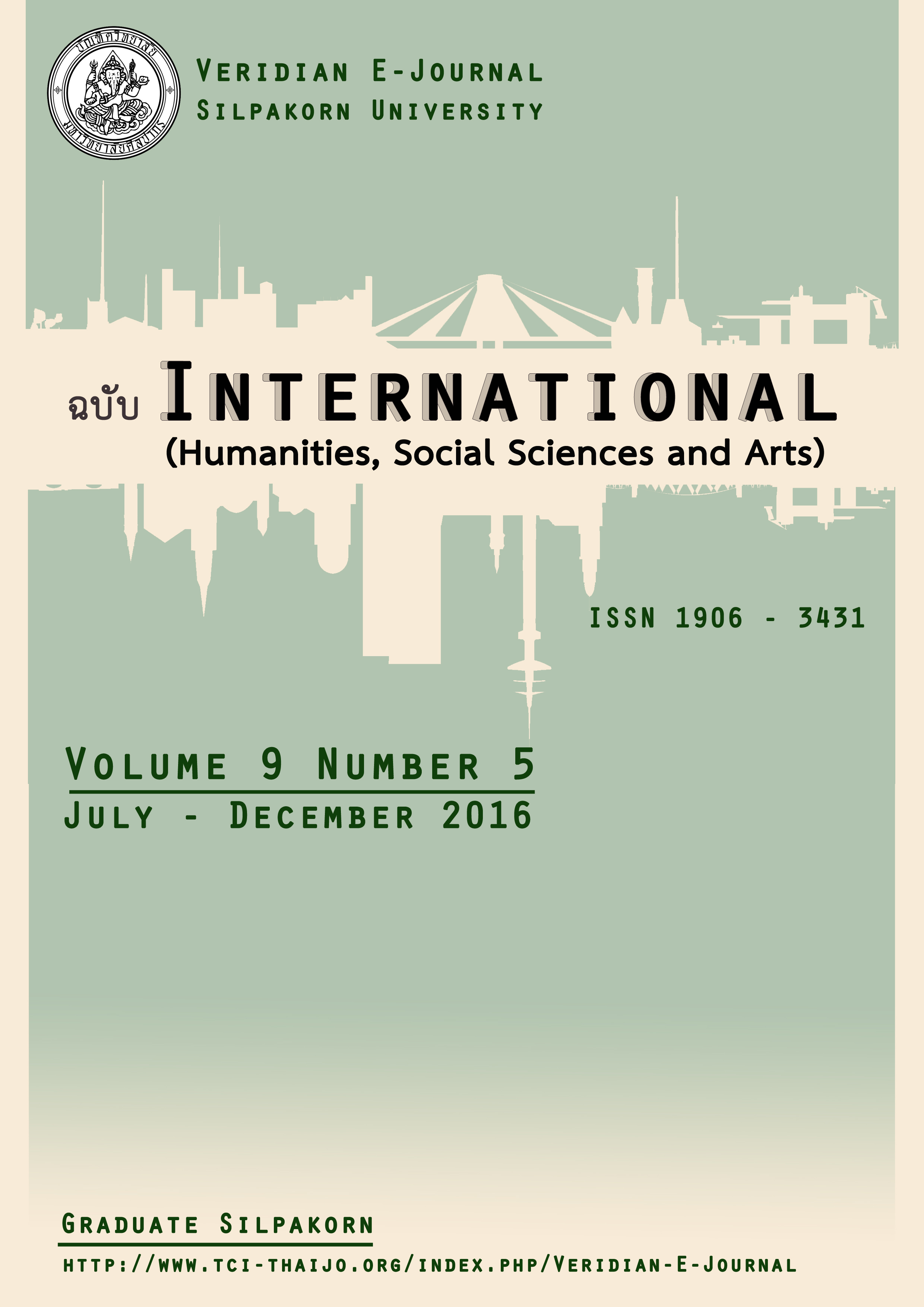Factors that affect the avidity for learning behavior of the undergraduate students at King Mongkut’s Institute of Technology Ladkrabang (KMITL): The path analysis
Main Article Content
Abstract
This research aimed 1) to study the avidity for learning behavior and factors that affect the avidity for learning behavior of the undergraduate students at KMITL and 2) to analyze the path of factors that affect the avidity for learning behavior of undergraduate students at KMITL. The sample consisted of 392 undergraduate students at KMITL in the academic year 2013 by stratified random sampling according to the faculties. The research instrument was the questionnaires of the avidity for learning behavior which had the overall reliability of 0.94 and the factors which had the overall reliability of 0.96. The data analysis of this behavior level and factors was analyzed by the descriptive statistics; in addition, the analysis of factors that affect the avidity for learning behavior was analyzed by the statistics of path analysis.
The results found that; the samples had the avidity for learning behavior at a high level (as mean equal to 3.63), and the factors that affect the avidity for learning behavior were at a high level of all variables by were sorted in descending as follows; the support of family, the learning motivation, the learning resources and the support of curriculum and teaching activities (as mean equal to 4.26, 4.00, 3.93 and 3.88 respectively).
The result of path analysis found that the factor model which affected the avidity for learning behavior of the undergraduate students at KMITL was able to describe the variance of students’ behavior equal to 69.5 percent. Moreover, the factor that affected the highest on the avidity for learning behavior is the learning motivation equal to 0.45. The subordinate factor was the learning resources that there was the direct effect value equal to 0.26 and the indirect effect value through the learning motivation equal to 0.05.
The support of curriculum and teaching activities, there was the direct effect value equal to 0.12 and the indirect effect value through the learning motivation equal to 0.18. In addition, the support of family, there was the indirect effect value through the learning motivation equal to 0.12.
When considering the internal variable as the mediator variable that was the learning motivation, found that all of external variables affected this factor directly. The curriculum support and teaching activities, there was the influence through the learning motivation at the highest effect value equal to 0.40. The subordinate factors were the family support at the effect value equal to 0.26, and the learning resources at the effect value equal to 0.11 respectively.
การวิจัยครั้งนี้มีวัตถุประสงค์ 1) เพื่อศึกษาพฤติกรรมการใฝ่รู้และปัจจัยที่ส่งผลต่อพฤติกรรมการใฝ่รู้ของนักศึกษาสถาบันเทคโนโลยีพระจอมเกล้าเจ้าคุณทหารลาดกระบัง และ 2) เพื่อวิเคราะห์เส้นทาง(Path Analysis) ปัจจัยที่ส่งต่อพฤติกรรมการใฝ่รู้ของนักศึกษาสถาบันเทคโนโลยีพระจอมเกล้าเจ้าคุณทหารลาดกระบัง กลุ่มตัวอย่างเป็นนักศึกษาระดับปริญญาตรี สถาบันเทคโนโลยีพระจอมเกล้าเจ้าคุณทหารลาดกระบัง ปีการศึกษา 2556 จำนวน 392 คน โดยสุ่มแบบแบ่งชั้นตามคณะ เครื่องมือที่ใช้ในการวิจัยเป็นแบบสอบถามเกี่ยวกับพฤติกรรมการใฝ่รู้ มีค่าความเชื่อมั่นในภาพรวม 0.94 และเกี่ยวกับปัจจัยที่ส่งผลต่อพฤติกรรมการใฝ่รู้มีค่าความเชื่อมั่นในภาพรวม 0.96 การวิเคราะห์ข้อมูลระดับพฤติกรรมการใฝ่รู้และปัจจัย ใช้สถิติเชิงพรรณนา และการวิเคราะห์ปัจจัยที่ส่งผลต่อพฤติกรรมการใฝ่รู้ใช้สถิติการวิเคราะห์เส้นทาง ผลการวิจัยพบว่า
กลุ่มตัวอย่างมีระดับพฤติกรรมการใฝ่รู้อยู่ในระดับมาก (ค่าเฉลี่ยเท่ากับ 3.63) และมีปัจจัยที่ส่งผลต่อพฤติกรรมการใฝ่รู้อยู่ในระดับมากทุกตัวแปร โดยเรียงลำดับจากมากที่สุดได้ดังนี้ การส่งเสริมจากครอบครัว, แรงจูงใจใฝ่เรียนรู้, แหล่งการเรียนรู้ และการส่งเสริมจากหลักสูตรและกิจกรรมการเรียนการสอน (ค่าเฉลี่ยเท่ากับ 4.26, 4.00, 3.93 และ 3.88 ตามลำดับ)
ผลการวิเคราะห์เส้นทาง พบว่าแบบจำลองปัจจัยที่ส่งผลต่อพฤติกรรมการใฝ่รู้ของนักศึกษาสถาบันเทคโนโลยีพระจอมเกล้าเจ้าคุณทหารลาดกระบัง สามารถอธิบายความแปรปรวนของพฤติกรรมการใฝ่รู้ของนักศึกษาได้ร้อยละ 69.5 และปัจจัยที่ส่งผลต่อพฤติกรรมการใฝ่รู้มากที่สุดคือ แรงจูงใจใฝ่เรียนรู้ มีอิทธิพลทางตรงต่อพฤติกรรมการใฝ่รู้ เท่ากับ .45 รองลงมาคือ แหล่งการเรียนรู้ มีค่าอิทธิพลทางตรง เท่ากับ .26 และมีค่าอิทธิพลทางอ้อมโดยผ่านแรงจูงใจใฝ่เรียนรู้ เท่ากับ .05 การส่งเสริมจากหลักสูตรและกิจกรรมการเรียนการสอนมีค่าอิทธิพลทางตรง เท่ากับ .12 และมีค่าอิทธิพลทางอ้อมโดยผ่านแรงจูงใจใฝ่เรียนรู้ เท่ากับ .18 และการส่งเสริมจากครอบครัว มีค่าอิทธิพลทางอ้อมโดยผ่านแรงจูงใจใฝ่เรียนรู้ เท่ากับ .12
และเมื่อพิจารณาตัวแปรภายในที่เป็นตัวแปรคั่นกลาง (Mediator variable) คือ แรงจูงใจใฝ่เรียนรู้ พบว่าตัวแปรภายนอกทุกตัวมีอิทธิพลทางตรงต่อแรงจูงใจใฝ่เรียนรู้ โดยที่การส่งเสริมจากหลักสูตรและกิจกรรมการเรียนการสอนมีอิทธิพลต่อแรงจูงใจใฝ่เรียนรู้มากที่สุด มีค่าอิทธิพลเท่ากับ .40 รองลงมาคือ การส่งเสริมจากครอบครัว มีค่าอิทธิพลเท่ากับ .26 และแหล่งการเรียนรู้ มีค่าอิทธิพลเท่ากับ .11

